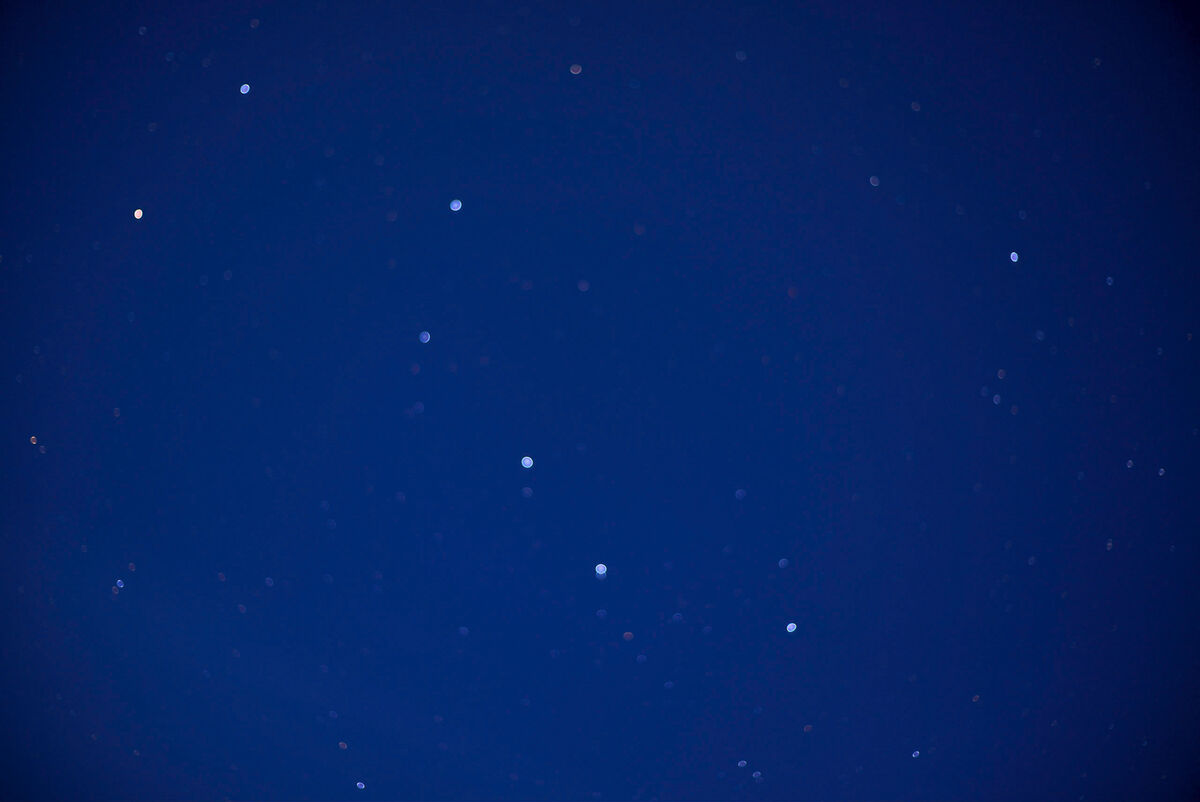Experimented photographing Stars
May 20, 2023 19:05:40 #
Jrkarra
Loc: Bridgewater, NJ
Last week I camped in Shenandoah national park , and tried for first time photographing the stars.
With my 50mm fixed lens, f2.2 and ISO 100, 20 secs shutter speed, i got stars in circular shapes the bright ones and very dim ones too.
I am aware that Earth's rotation plays an important role.
Here are my questions::
1. Did you guys got in the same way for similar metadata??
2. On the top left corner, I noticed something in light orange. Any idea what it could be? My guess is that it might be Andromeda galaxy.
Second attachment is the photo, first is a screenshot.
Thanks
Sastry Karra
With my 50mm fixed lens, f2.2 and ISO 100, 20 secs shutter speed, i got stars in circular shapes the bright ones and very dim ones too.
I am aware that Earth's rotation plays an important role.
Here are my questions::
1. Did you guys got in the same way for similar metadata??
2. On the top left corner, I noticed something in light orange. Any idea what it could be? My guess is that it might be Andromeda galaxy.
Second attachment is the photo, first is a screenshot.
Thanks
Sastry Karra
May 20, 2023 19:09:01 #
BooIsMyCat
Loc: Somewhere
Jrkarra wrote:
Last week I camped in Shenandoah national park , a... (show quote)
Definitely not Andromeda galaxy.
Your camera is not in focus. That is why you are getting those oblong rings.
You are displaying the big dipper. Each star should be "round" and a solid white dot.
May 20, 2023 19:52:35 #
larryepage
Loc: North Texas area
Jrkarra wrote:
Last week I camped in Shenandoah national park , a... (show quote)
You don't say what camera you are using. It can make a big difference. 50mm isn't ideal for night sky photography, but with some effort, you could make it work by shooting and assembling a panorama. But to get your individual images, I would suggest the following approach:
Before dark, find infinity focus, then turn off AF and tape your focus ring in place to keep it from shifting. Correct focus is a requirement, and you are not going to achieve it with AF. You also cannot depend on the infinity indicator on your lens to tell you where to focus.
For your lens, you are going to need to use f/2 as your shooting aperture. You will be using Manual Exposure for all settings.
The Rule of 500 says that for a 50mm lens, 10 seconds is the maximum exposure without obvious star trails. For that to work at f/2, you are going to need an ISO setting of at least 4,000. This will probably not be enough exposure, and you will probably need to stretch your expisure to 20 seconds. This will likely result in some trailing, but is likely the best you can do with that lens.
Please note that location is a problem for you. Most spots in the eastern US offer high humidities and low elevation. The low elevation means more atmosphere to shoot through, causing loss of exposure and clarity.
Finally, you are going to need to be capturing raw files, and you are going to need to do post orocessing to bring your images out og the shadows. If your camera is an older model, it may not have enough dynamic range at the necessary ISO to allow you to capture anything but the brightest stars.
Try again with this setup and see if you capture more of what's there.
May 21, 2023 00:51:51 #
Orphoto
Loc: Oregon
I agree with the above. Stars come in a range of colors. Dont be surprised to see all kinds. If the temperatures are changing much dont tape to maintain focus. Learn to use live view to focus,if your camera offers it.
May 21, 2023 06:58:11 #
The 500 Rule is a minimum for point stars. It is based on 35mm photography. For crop sensor or M4/3 cameras you need to use the 35mm equivalent focal length.
PhotoPills has a calculator.
PhotoPills has a calculator.
May 21, 2023 16:26:38 #
jcryan
Loc: Las Terrenas, Dominican Republic
If you are having trouble with star trails being produced in a too long exposure, I recommend you try the techniques described by Nico Carver on his YouTube channel Nebula Photos. The basic technique is to take a number of photos and, using free or purchased astronomy software, stack them to increase the effective exposure, then "stretch" the stacked image to bring out the details.
The YouTube playlist below shows this in a series of three videos about photographing the Orion Nebula. You can adapt his methodology for star field photos by decreasing the number of photos you take.
https://youtube.com/playlist?list=PLrzbdmripj1c9p7hzt7ffgH3oN8vzCFI3
The YouTube playlist below shows this in a series of three videos about photographing the Orion Nebula. You can adapt his methodology for star field photos by decreasing the number of photos you take.
https://youtube.com/playlist?list=PLrzbdmripj1c9p7hzt7ffgH3oN8vzCFI3
May 22, 2023 11:02:57 #
Jrkarra
Loc: Bridgewater, NJ
Thanks to all for responding immediately and above all sharing a lot of information.
I will try again on June 18 when I camp in Caledonia state park in PA.
Last time it rained heavily the previous night and looks like there was a lot of moisture in the atmosphere.
Hoping for dry atmosphere this time.
In the meantime I will go thru the YouTube videos suggested by one of you.
Thanks again for everything
Sastry Karra
I will try again on June 18 when I camp in Caledonia state park in PA.
Last time it rained heavily the previous night and looks like there was a lot of moisture in the atmosphere.
Hoping for dry atmosphere this time.
In the meantime I will go thru the YouTube videos suggested by one of you.
Thanks again for everything
Sastry Karra
May 22, 2023 20:21:09 #
Jrkarra wrote:
Thanks to all for responding immediately and above all sharing a lot of information.
I will try again on June 18 when I camp in Caledonia state park in PA.
Last time it rained heavily the previous night and looks like there was a lot of moisture in the atmosphere.
Hoping for dry atmosphere this time.
In the meantime I will go thru the YouTube videos suggested by one of you.
Thanks again for everything
Sastry Karra
I will try again on June 18 when I camp in Caledonia state park in PA.
Last time it rained heavily the previous night and looks like there was a lot of moisture in the atmosphere.
Hoping for dry atmosphere this time.
In the meantime I will go thru the YouTube videos suggested by one of you.
Thanks again for everything
Sastry Karra
A different place to try is Cherry Springs State Park, 15 miles southeast of Coudersport, PA. It is reported to be one of the darkest places in the state.
May 26, 2023 07:02:58 #
bbrown5154
Loc: Baltimore, MD
Jrkarra wrote:
Last week I camped in Shenandoah national park , a... (show quote)
A couple of things. First off you're not in focus, that's why the stars kind of have that oval/egg look to them and then your ISO is waaayyyy too low to be doing night photography.
Fix those 2 things first then see what happens.
Good Luck.
May 26, 2023 07:08:06 #
May 26, 2023 07:09:57 #
bbrown5154
Loc: Baltimore, MD
Jrkarra wrote:
Thanks to all for responding immediately and above all sharing a lot of information.
I will try again on June 18 when I camp in Caledonia state park in PA.
Last time it rained heavily the previous night and looks like there was a lot of moisture in the atmosphere.
Hoping for dry atmosphere this time.
In the meantime I will go thru the YouTube videos suggested by one of you.
Thanks again for everything
Sastry Karra
I will try again on June 18 when I camp in Caledonia state park in PA.
Last time it rained heavily the previous night and looks like there was a lot of moisture in the atmosphere.
Hoping for dry atmosphere this time.
In the meantime I will go thru the YouTube videos suggested by one of you.
Thanks again for everything
Sastry Karra
There is also a really nice dark sky park/area in PA called Cherry Springs St. Park in Potter County.
Aug 13, 2023 20:29:23 #
samjam
Loc: Illinois-Wisconsin Border
How did you focus the camera? When photographing Stars, Meteors, Moon, or other things in the night sky do NOT use autofocus. Switch to manual focus, and set to infinity (on the lens there will be what looks like a number 8 laying on its side) then back off just a little bit. It's also best to use a remote shutter release or use a delay timer for the shutter. Don't handhold the camera, as most of the time you will want a slow shutter speed of multiple seconds, not fractions of a second. The only object in the night sky you can get away with handholding is photographing the moon. Full moon shots start at ISO 100-125, lens F11, shutter speed 1/125, and then adjust the shutter speed for best exposure.
Remember to keep your stars crisp you want to follow the 500 rule, this will prevent star trails in your photo due to the movement of the Earth. You divide 500 by the focal length of your lens. So if you're using a 50mm lens you can have your shutter open and remain open for up to 10 seconds and will remain well focused, 24mm lens about 20 seconds with no focus issues. Anything beyond that will make the focus more blurred and if you leave it open too much longer you get long white lines going through the photo.
That's where I start and you can always make slight adjustments to make the picture optimal.
Remember to keep your stars crisp you want to follow the 500 rule, this will prevent star trails in your photo due to the movement of the Earth. You divide 500 by the focal length of your lens. So if you're using a 50mm lens you can have your shutter open and remain open for up to 10 seconds and will remain well focused, 24mm lens about 20 seconds with no focus issues. Anything beyond that will make the focus more blurred and if you leave it open too much longer you get long white lines going through the photo.
That's where I start and you can always make slight adjustments to make the picture optimal.
Nov 13, 2023 13:11:33 #
Most of the replies are great advice. Between now and your next trip you might look into buying a used ultra wide angle lens such as the Samyang or (Rokinon) 14mm f2.8 manual lens for FF or a 12mm for crop sensor. They are very reasonably priced around $150. These are manual lenses which is actually the easiest to use for star photography.
If you want to reply, then register here. Registration is free and your account is created instantly, so you can post right away.





